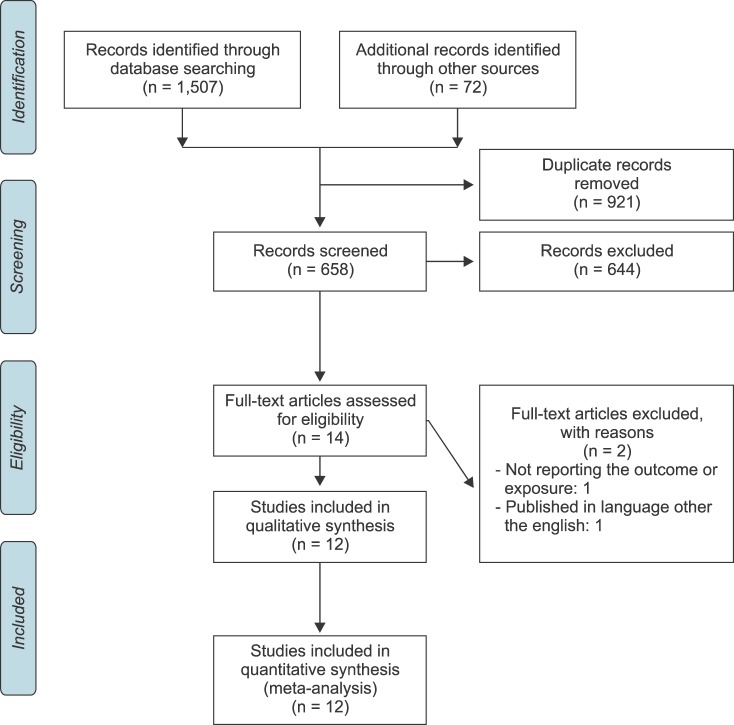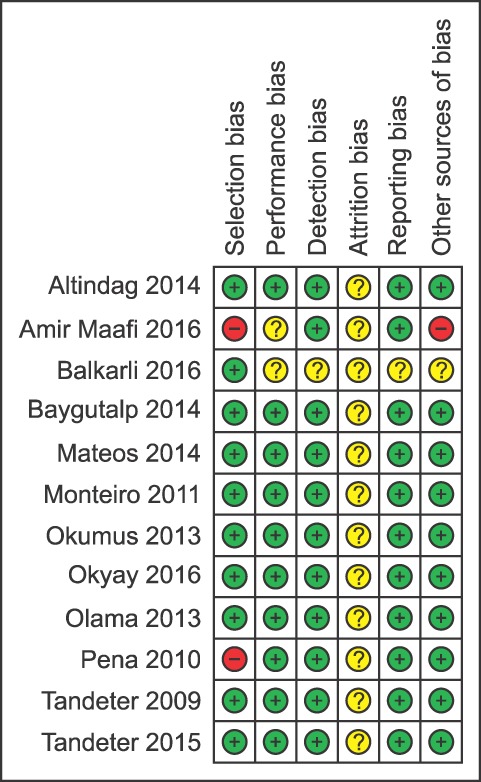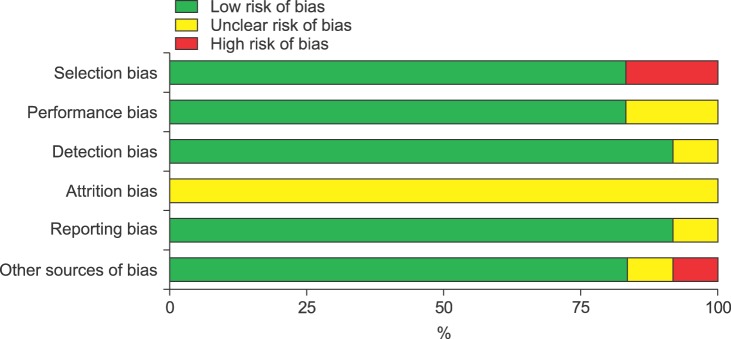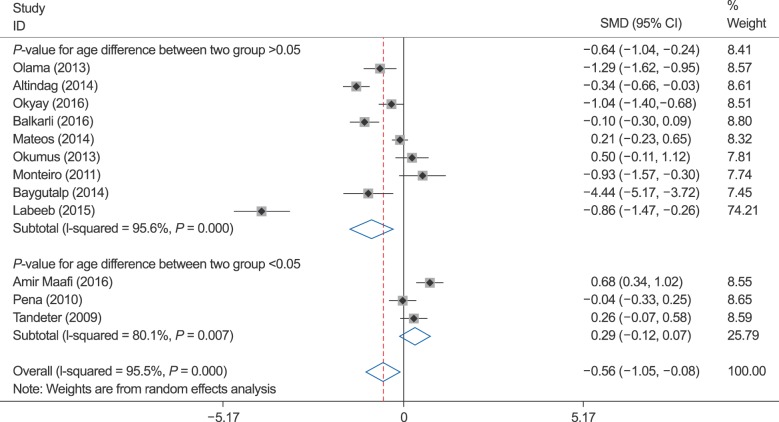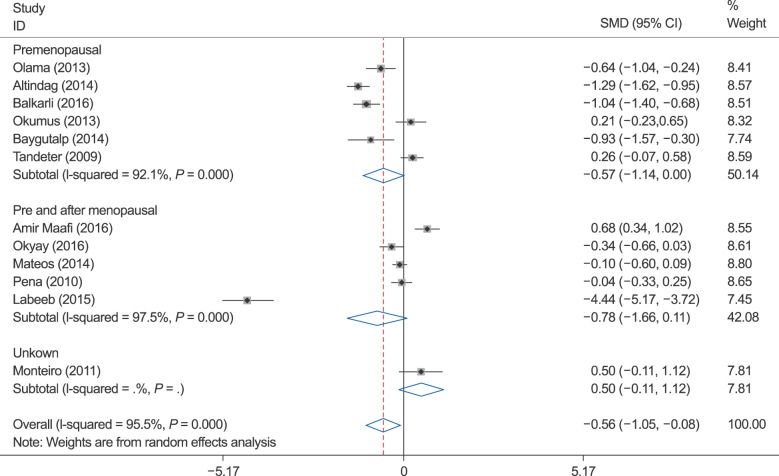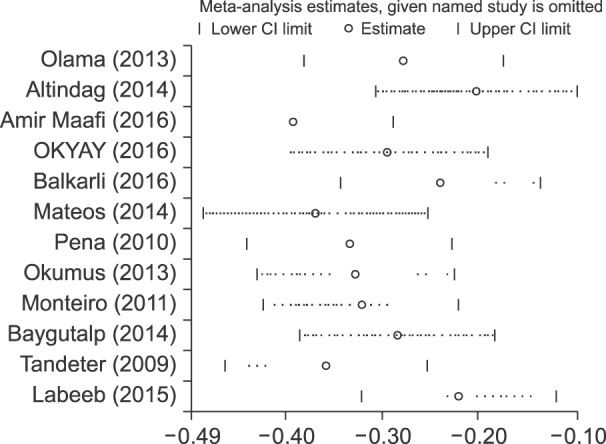Korean J Pain.
2017 Oct;30(4):250-257. 10.3344/kjp.2017.30.4.250.
Vitamin D and fibromyalgia: a meta-analysis
- Affiliations
-
- 1Gastrointestinal Cancer Research Center, Mazandaran University of Medical Sciences, Sari, Iran.
- 2Department of Community Medicine, Zabol University of Medical Sciences, Zabol, Iran.
- 3Health Science Research Center, Addiction Institute, Mazandaran University of Medical Sciences, Sari, Iran. mmoosazadeh1351@gmail.com
- KMID: 2392901
- DOI: http://doi.org/10.3344/kjp.2017.30.4.250
Abstract
- Vitamin D is a cofactor responsible for autoimmune disorders. There is no agreement in the studies investigating the association between vitamin D and fibromyalgia. This study aims to combine the conflicting results of the primary studies which compared these patients with control groups regarding the serum concentration of vitamin D. This meta-analysis has been designed based on PRISMA guidelines. Relevant keywords were searched in PubMed, Science direct, Scopus, Cochrane, and Google scholar and primary studies were selected. After screening the eligible studies according to inclusion/exclusion criteria, we investigated the risk of bias in the selected studies and also the heterogeneity between the primary results using Cochrane (Q) and I-squared (I2) indices. The primary results were combined using inverse variance method and Cohen statistics as well as a random effects model. Publication bias was assessed using Egger test. Sensitivity analysis was applied to investigate the influence of each primary study on the final result of the meta-analysis. Suspected factors in the heterogeneity were assessed using meta-regression models. We entered 12 eligible studies in the meta-analysis including 851 cases compared with 862 controls. The standardized mean difference of Vitamin D between the two groups was −0.56 (95% confidence interval: −1.05, −0.08). Our meta-analysis showed that vitamin D serum levels of patients with fibromyalgia was significantly lower than that of control group.
Keyword
MeSH Terms
Figure
Cited by 1 articles
-
Effect of Vitamin D Deficiency on the Frequency of Headaches in Migraine
Tae-Jin Song, Min-Kyung Chu, Jong-Hee Sohn, Hong-Yup Ahn, Sun Hwa Lee, Soo-Jin Cho
J Clin Neurol. 2018;14(3):366-373. doi: 10.3988/jcn.2018.14.3.366.
Reference
-
1. Olama SM, Senna MK, Elarman MM, Elhawary G. Serum vitamin D level and bone mineral density in premenopausal Egyptian women with fibromyalgia. Rheumatol Int. 2013; 33:185–192. PMID: 22311432.
Article2. Wolfe F, Smythe HA, Yunus MB, Bennett RM, Bombardier C, Goldenberg DL, et al. The American college of rheumatology 1990 criteria for the classification of fibromyalgia. Report of the multicenter criteria committee. Arthritis Rheum. 1990; 33:160–172. PMID: 2306288.
Article3. Okyay R, Koçyigit B, Gürsoy S. Vitamin D levels in women with fibromyalgia and relationship between pain, tender point count and disease activity. Acta Med Mediterr. 2016; 32:243–247.4. Labeeb AA, Al-Sharaki DR. Detection of serum 25(OH)-vitamin D level in the serum of women with fibromyalgia syndrome and its relation to pain severity. Egypt Rheumatol Rehabil. 2015; 42:196–200.
Article5. Baygutalp NK, Baygutalp F, Şeferoğlu B, Bakan E. The relation between serum vitamin D levels and clinical findings of fibromyalgia syndrome. Dicle Med J. 2014; 41:446–450.
Article6. Abokrysha NT. Vitamin D deficiency in women with fibromyalgia in Saudi Arabia. Pain Med. 2012; 13:452–458. PMID: 22221390.
Article7. Abeles AM, Pillinger MH, Solitar BM, Abeles M. Narrative review: the pathophysiology of fibromyalgia. Ann Intern Med. 2007; 146:726–734. PMID: 17502633.
Article8. Wood PB, Holman AJ, Jones KD. Novel pharmacotherapy for fibromyalgia. Expert Opin Investig Drugs. 2007; 16:829–841.
Article9. Bergman S. Management of musculoskeletal pain. Best Pract Res Clin Rheumatol. 2007; 21:153–166. PMID: 17350550.
Article10. Arnold LM, Clauw DJ, Dunegan LJ, Turk DC. FibroCollaborative. A framework for fibromyalgia management for primary care providers. Mayo Clin Proc. 2012; 87:488–496. PMID: 22560527.
Article11. Bhatty SA, Shaikh NA, Irfan M, Kashif SM, Vaswani AS, Sumbhai A, et al. Vitamin D deficiency in fibromyalgia. J Pak Med Assoc. 2010; 60:949–951. PMID: 21375201.12. Atherton K, Berry DJ, Parsons T, Macfarlane GJ, Power C, Hyppönen E. Vitamin D and chronic widespread pain in a white middle-aged British population: evidence from a cross-sectional population survey. Ann Rheum Dis. 2009; 68:817–822. PMID: 18697776.
Article13. Plotnikoff GA, Quigley JM. Prevalence of severe hypovitaminosis D in patients with persistent, nonspecific musculoskeletal pain. Mayo Clin Proc. 2003; 78:1463–1470. PMID: 14661675.
Article14. Altindag O, Ögüt E, Gur A, Gursoy S, Gunay M. Serum vitamin D level and its relation with clinical parameters in fibromyalgia as a neuropathic pain. Orthop Muscular Syst. 2014; 3:171.
Article15. Ulusoy H, Sarica N, Arslan S, Ozyurt H, Cetin I, Birgul Ozer E, et al. Serum vitamin D status and bone mineral density in fibromyalgia. Bratisl Lek Listy. 2010; 111:604–609. PMID: 21384747.16. Okumus M, Koybası M, Tuncay F, Ceceli E, Ayhan F, Yorgancioglu R, et al. Fibromyalgia syndrome: is it related to vitamin D deficiency in premenopausal female patients? Pain Manag Nurs. 2013; 14:e156–e163. PMID: 24315268.
Article17. Moher D, Liberati A, Tetzlaff J, Altman DG. PRISMA Group. Preferred reporting items for systematic reviews and meta-analyses: the PRISMA statement. J Clin Epidemiol. 2009; 62:1006–1012. PMID: 19631508.
Article18. Landis JR, Koch GG. The measurement of observer agreement for categorical data. Biometrics. 1977; 33:159–174. PMID: 843571.
Article19. Higgins JP, Green S. Cochrane handbook for systematic reviews of interventions version 5.1.0 [Internet]. London: The Cochrane Collaboration;2011. cited 2011 March 3. Available at http://handbook.cochrane.org.20. Viswanathan M, Ansari MT, Berkman ND, Chang S, Hartling L, McPheeters M, et al. Assessing the risk of bias of individual studies in systematic reviews of health care interventions [Internet]. Rockville (MD): Agency for Healthcare Research and Quality;2012. cited 2012 March 8. Available at https://www.ncbi.nlm.nih.gov/pubmedhealth/PMH0077771/.21. Higgins JP, Thompson SG. Quantifying heterogeneity in a meta-analysis. Stat Med. 2002; 21:1539–1558. PMID: 12111919.
Article22. Al-Allaf AW, Mole PA, Paterson CR, Pullar T. Bone health in patients with fibromyalgia. Rheumatology (Oxford). 2003; 42:1202–1206. PMID: 12810939.
Article23. Maafi AA, Ghavidel-Parsa B, Haghdoost A, Aarabi Y, Hajiabbasi A, Shenavar Masooleh I, et al. Serum vitamin D status in Iranian fibromyalgia patients: according to the symptom severity and illness invalidation. Korean J Pain. 2016; 29:172–178. PMID: 27413482.
Article24. Balkarli A, Balkarlı H, Temel S, Ozhan N, Ozkan U, Cobankara V. AB0656 Serum vitamin D and parathyroid hormone levels in premenopausal women with fibromyalgia syndrome. Ann Rheum Dis. 2013; 72:A989.25. Mateos F, Valero C, Olmos JM, Casanueva B, Castillo J, Martínez J, et al. Bone mass and vitamin D levels in women with a diagnosis of fibromyalgia. Osteoporos Int. 2014; 25:525–533. PMID: 24008400.
Article26. Monteiro DM. Evaluation of vitamin D status in a population with fibromyalgia [master thesis]. Coimbra: Univ. of Coimbra;2011.27. Özcan DS, Öken Ö, Aras M, Köseoğlu BF. Vitamin D levels in women with fibromyalgia and relationship between pain, depression, and sleep. Turk J Phys Med Rehabil. 2014; 60:329–334.
Article28. de Rezende Pena C, Grillo LP, das Chagas Medeiros MM. Evaluation of 25-hydroxyvitamin D serum levels in patients with fibromyalgia. J Clin Rheumatol. 2010; 16:365–369. PMID: 21085020.
Article29. Tandeter H, Grynbaum M, Zuili I, Shany S, Shvartzman P. Serum 25-OH vitamin D levels in patients with fibromyalgia. Isr Med Assoc J. 2009; 11:339–342. PMID: 19697583.
- Full Text Links
- Actions
-
Cited
- CITED
-
- Close
- Share
- Similar articles
-
- Neuropathic Pain and its Relationship With Fibromyalgia, Vitamin D Status and Medication Use in Patients With Ankylosing Spondylitis
- Efficacy and safety of low-dose naltrexone for the management of fibromyalgia: a systematic review and meta-analysis of randomized controlled trials with trial sequential analysis
- Circulating levels of vitamin D, vitamin D receptor polymorphisms, and colorectal adenoma: a meta-analysis
- Fibromyalgia : an Overveiw
- Effect of Vitamin D on Muscular Strength in Postmenopausal Women: A Meta-Analysis

